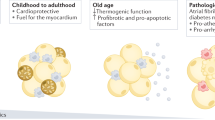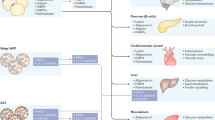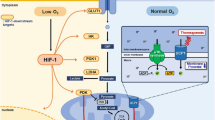Abstract
Epicardial adipose tissue is a unique fat depot around the heart that shares a close anatomic proximity and vascular supply with the myocardium and coronary arteries. Its accumulation around the heart, measured using various imaging modalities, has been associated with the onset and progression of coronary artery disease in humans. Epicardial adipose tissue is also the only fat depot around the heart that is known to express uncoupling protein 1 at both mRNA and protein levels in the detectable range. Recent advances have further indicated that human epicardial fat exhibits beige fat-like features. Here we provide an overview of the physiological and pathophysiological relevance of human epicardial fat, and further discuss whether its thermogenic properties can serve as a target for the therapeutic management of coronary heart disease in humans.
This is a preview of subscription content, access via your institution
Access options
Subscribe to this journal
We are sorry, but there is no personal subscription option available for your country.
Buy this article
- Purchase on Springer Link
- Instant access to full article PDF
Prices may be subject to local taxes which are calculated during checkout

Similar content being viewed by others
References
Alexopoulos N, McLean DS, Janik M, Arepalli CD, Stillman AE, Raggi P . Epicardial adipose tissue and coronary artery plaque characteristics. Atherosclerosis 2010; 210: 150–154.
Baker AR, Harte AL, Howell N, Pritlove DC, Ranasinghe AM, da Silva NF et al. Epicardial adipose tissue as a source of nuclear factor-κb and c-jun n-terminal kinase mediated inflammation in patients with coronary artery disease. J Clin Endocrinol Metab 2009; 94: 261–267.
Rosito GA, Massaro JM, Hoffmann U, Ruberg FL, Mahabadi AA, Vasan RS et al. Pericardial fat, visceral abdominal fat, cardiovascular disease risk factors, and vascular calcification in a community-based sample: the Framingham Heart Study. Circulation 2008; 117: 605–613.
Ding J, Hsu FC, Harris TB, Liu Y, Kritchevsky SB, Szklo M et al. The association of pericardial fat with incident coronary heart disease: the Multi-Ethnic Study of Atherosclerosis (MESA). Am J Clin Nutr 2009; 90: 499–504.
Marchington JM, Pond CM . Site-specific properties of pericardial and epicardial adipose tissue: the effects of insulin and high-fat feeding on lipogenesis and the incorporation of fatty acids in vitro. Int J Obes (Lond) 1990; 14: 1013–1022.
Chechi K, Blanchard PG, Mathieu P, Deshaies Y, Richard D . Brown fat like gene expression in the epicardial fat depot correlates with circulating HDL-cholesterol and triglycerides in patients with coronary artery disease. Int J Cardiol 2012; 167: 2264–2270.
Sharma AM . Mediastinal fat, insulin resistance, and hypertension. Hypertension 2004; 44: 117–118.
Gaborit B, Abdesselam I, Dutour A . Epicardial fat: more than just an ‘epi’ phenomenon? Horm Metab Res 2013; 45: 991–1001.
Iacobellis G, Leonetti F, Di Mario U . Images in cardiology: massive epicardial adipose tissue indicating severe visceral obesity. Clin Cardiol 2003; 26: 237.
Mahabadi AA, Massaro JM, Rosito GA, Levy D, Murabito JM, Wolf PA et al. Association of pericardial fat, intrathoracic fat, and visceral abdominal fat with cardiovascular disease burden: the Framingham Heart Study. Eur Heart J 2009; 30: 850–856.
Meijer RI, Serne EH, Smulders YM, van Hinsbergh VWM, Yudkin JS, Eringa EC . Perivascular adipose tissue and its role in type 2 diabetes and cardiovascular disease. Curr Diab Rep 2011; 11: 211–217.
Lee HY, Després JP, Koh KK . Perivascular adipose tissue in the pathogenesis of cardiovascular disease. Atherosclerosis 2013; 230: 177–184.
Xu Y, Cheng X, Hong K, Huang C, Wan L . How to interpret epicardial adipose tissue as a cause of coronary artery disease: a meta-analysis. Coron Artery Dis 2012; 23: 227–233.
Rabkin SW . Epicardial fat: properties, function and relationship to obesity. Obes Rev 2007; 8: 253–261.
Iacobellis G . Epicardial and pericardial fat: close, but very different. Obesity (Silver Spring) 2009; 17: 625–627.
Talman AH, Psaltis PJ, Cameron JD, Meredith IT, Seneviratne SK, Wong DTL . Epicardial adipose tissue: far more than a fat depot. Cardiovasc Diagn Ther 2014; 4: 416–429.
Mahabadi AA, Reinsch N, Lehmann N, Altenbernd J, Kälsch H, Seibel RM et al. Association of pericoronary fat volume with atherosclerotic plaque burden in the underlying coronary artery: a segment analysis. Atherosclerosis 2010; 211: 195–199.
Raggi P, Alakija P . Epicardial adipose tissue: a long-overlooked marker of risk of cardiovascular disease. Atherosclerosis 2013; 229: 32–33.
Raggi P . Epicardial adipose tissue as a marker of coronary artery disease risk. J Am Coll Cardiol 2013; 61: 1396–1397.
Yamaguchi Y, Cavallero S, Patterson M, Shen H, Xu J, Kumar SR et al. Adipogenesis and epicardial adipose tissue: a novel fate of the epicardium induced by mesenchymal transformation and PPARγ activation. Proc Natl Acad Sci USA 2015; 112: 2070–2075.
Corradi D, Maestri R, Callegari S, Pastori P, Goldoni M, Luong TV et al. The ventricular epicardial fat is related to the myocardial mass in normal, ischemic and hypertrophic hearts. Cardiovasc Pathol 2004; 13: 313–316.
Iacobellis G, Bianco AC . Epicardial adipose tissue: emerging physiological, pathophysiological and clinical features. Trends Endocrinol Metab 2011; 22: 450–457.
Marchington JM, Mattacks CA, Pond CM . Adipose tissue in the mammalian heart and pericardium: structure, foetal development and biochemical properties. Comp Biochem Physiol B 1989; 94: 225–232.
Iacobellis G . Local and systemic effects of the multifaceted epicardial adipose tissue depot. Nat Rev Endocrinol 2015; 11: 363–371.
Arora RC, Waldmann M, Hopkins DA . Porcine intrinsic cardiac ganglia. Anat Rec A Discov Mol Cell Evol Biol 2003; 27: 249–258.
Sacks HS, Fain JN, Holman B, Cheema P, Chary A, Parks F et al. Uncoupling protein-1 and related messenger ribonucleic acids in human epicardial and other adipose tissues: epicardial fat functioning as brown fat. J Clin Endocrinol Metab 2009; 94: 3611–3615.
Sacks HS, Fain JN . Human epicardial fat: what is new and what is missing? Clin Exp Pharmacol Physiol 2011; 38: 879–887.
Fain JN, Sacks HS, Buehrer B, Bahouth SW, Garrett E, Wolf RY et al. Identification of omentin mRNA in human epicardial adipose tissue: comparison to omentin in subcutaneous, internal mammary artery periadventitial and visceral abdominal depots. Int J Obes 2008; 32: 810–815.
Swifka J, Weiss J, Addicks K, Eckel J, Rösen P . Epicardial fat from guinea pig: a model to study the paracrine network of interactions between epicardial fat and myocardium? Cardiovasc Drugs Ther 2008; 22: 107–114.
Greif M, Becker A, von Ziegler F, Lebherz C, Lehrke M, Broedl UC et al. Pericardial adipose tissue determined by dual source CT is a risk factor for coronary atherosclerosis. Arterioscler Thromb Vasc Biol 2009; 29: 781–786.
Strissel KJ, Denis GV, Nikolajczyk BS . Immune regulators of inflammation in obesity-associated type 2 diabetes and coronary artery disease. Curr Opin Endocrinol Diabetes Obes 2014; 21: 330–338.
Tamarappoo B, Dey D, Shmilovich H, Nakazato R, Gransar H, Cheng VY et al. Increased pericardial fat volume measured from noncontrast CT predicts myocardial ischemia by SPECT. JACC Cardiovasc Imaging 2010; 3: 1104–1112.
Mahabadi AA, Berg MH, Lehmann N, Kälsch H, Bauer M, Kara K et al. Association of epicardial fat with cardiovascular risk factors and incident myocardial infarction in the general population: The Heinz Nixdorf Recall Study. J Am Coll Cardiol 2013; 61: 1388–1395.
Yerramasu A, Dey D, Venuraju S, Anand DV, Atwal S, Corder R et al. Increased volume of epicardial fat is an independent risk factor for accelerated progression of sub-clinical coronary atherosclerosis. Atherosclerosis 2012; 220: 223–230.
Bachar GN, Dicker D, Kornowski R, Atar E . Epicardial adipose tissue as a predictor of coronary artery disease in asymptomatic subjects. Am J Cardiol 2012; 110: 534–538.
Echavarría-Pinto M, Hernando L, Alfonso F . From the epicardial adipose tissue to vulnerable coronary plaques. World J Cardiol 2013; 5: 68–74.
Snel M, Jonker JT, Hammer S, Kerpershoek G, Lamb HJ, Meinders AE et al. Long-term beneficial effect of a 16-week very low calorie diet on pericardial fat in obese type 2 diabetes mellitus patients. Obesity 2012; 20: 1572–1576.
Khalaf KI, Taegtmeyer H . Slimming the heart with bariatric surgery. J Am Coll Cardiol 2013; 61: 990–991.
Kim MK, Tomita T, Kim MJ, Sasai H, Maeda S, Tanaka K . Aerobic exercise training reduces epicardial fat in obese men. J Appl Physiol 2009; 106: 5–11.
Liang KW, Tsai IC, Lee WJ, Lin SY, Lee WL, Lee IT et al. Correlation between reduction of superior interventricular groove epicardial fat thickness and improvement of insulin resistance after weight loss in obese men. Diabetol Metab Syndr 2014; 6: 115.
McKenney ML, Schultz KA, Boyd JH, Byrd JP, Alloosh M, Teague SD et al. Epicardial adipose excision slows the progression of porcine coronary atherosclerosis. J Cardiothorac Surg 2014; 9: 2.
Iacobellis G, Ribaudo MC, Assael F, Vecci E, Tiberti C, Zappaterreno A et al. Echocardiographic epicardial adipose tissue is related to anthropometric and clinical parameters of metabolic syndrome: a new indicator of cardiovascular risk. J Clin Endocrinol Metab 2003; 88: 5163–5168.
Payne GA, Kohr MC, Tune JD . Epicardial perivascular adipose tissue as a therapeutic target in obesity-related coronary artery disease. Br J Pharmacol 2012; 165: 659–669.
Bettencourt N, Toschke AM, Leite D, Rocha J, Carvalho M, Sampaio F et al. Epicardial adipose tissue is an independent predictor of coronary atherosclerotic burden. Int J Cardiol 2012; 158: 26–32.
Iwayama T, Nitobe J, Watanabe T, Ishino M, Tamura H, Nishiyama S et al. Role of epicardial adipose tissue in coronary artery disease in non-obese patients. J Cardiol 2014; 63: 344–349.
Yong HS, Kim EJ, Seo HS, Kang EY, Kim YK, Woo OH et al. Pericardial fat is more abundant in patients with coronary atherosclerosis and even in the non-obese patients: evaluation with cardiac CT angiography. Int J Cardiovasc Imaging 2010; 26: 53–62.
Ishikawa Y, Ishii T, Asuwa N, Masuda S . Absence of atherosclerosis evolution in the coronary arterial segment covered by myocardial tissue in cholesterol-fed rabbits. Virchows Arch 1997; 430: 163–171.
Yudkin JS, Eringa E, Stehouwer C . ‘Vasocrine’ signalling from perivascular fat: a mechanism linking insulin resistance to vascular disease. Lancet 2005; 365: 1817–1820.
Mazurek T . Human epicardial adipose tissue is a source of inflammatory mediators. Circulation 2003; 108: 2460–2466.
Cheng KH, Chu CS, Lee KT, Lin TH, Hsieh CC, Chiu CC et al. Adipocytokines and proinflammatory mediators from abdominal and epicardial adipose tissue in patients with coronary artery disease. Int J Obes 2007; 32: 268–274.
Hirata Y, Tabata M, Kurobe H, Motoki T, Akaike M, Nishio C et al. Coronary atherosclerosis Is associated with macrophage polarization in epicardial adipose tissue. J Am Coll Cardiol 2011; 58: 248–255.
Salgado-Somoza A, Teijeira-Fernández E, Fernández AL, González-Juanatey JR, Eiras S . Proteomic analysis of epicardial and subcutaneous adipose tissue reveals differences in proteins involved in oxidative stress. Am J Physiol Heart Circ Physiol 2010; 299: H202–H209.
Karastergiou K, Evans I, Ogston N, Miheisi N, Nair D, Kaski JC et al. Epicardial adipokines in obesity and coronary artery disease induce atherogenic changes in monocytes and endothelial cells. Arterioscler Thromb Vasc Biol 2010; 30: 1340–1346.
Greulich S, Maxhera B, Vandenplas G, de Wiza DH, Smiris K, Mueller H et al. Secretory products from epicardial adipose tissue of patients with type 2 diabetes mellitus induce cardiomyocyte dysfunction. Circulation 2012; 126: 2324–2334.
Greulich S, de Wiza DH, Preilowski S . Secretory products of guinea pig epicardial fat induce insulin resistance and impair primary adult rat cardiomyocyte function. J Cell Mol Med 2011; 15: 2399–2410.
Tadros TM, Massaro JM, Rosito GA, Hoffmann U, Vasan RS, Larson MG et al. Pericardial fat volume correlates with inflammatory markers: the Framingham Heart Study. Obesity 2010; 18: 1039–1045.
Granér M, Seppälä-Lindroos A, Rissanen A, Hakkarainen A, Lundbom N, Kaprio J et al. Epicardial fat, cardiac dimensions, and low-grade inflammation in young adult monozygotic twins discordant for obesity. Am J Cardiol 2012; 109: 1295–1302.
Chechi K, Carpentier AC, Richard D . Understanding the brown adipocyte as a contributor to energy homeostasis. Trends Endocrinol Metab 2013; 8: 408–420.
Richard D, Monge-Roffarello B, Chechi K, Labbé SM, Turcotte EE . Control and physiological determinants of sympathetically mediated brown adipose tissue thermogenesis. Front Endocrinol (Lausanne) 2012; 3: 36.
Ouellet V, Routhier-Labadie A, Bellemare W, Lakhal-Chaieb L, Turcotte E, Carpentier AC et al. Outdoor temperature, age, sex, body mass index, and diabetic status determine the prevalence, mass, and glucose-uptake activity of 18F-FDG-detected BAT in humans. J Clin Endocrinol Metab 2011; 96: 92–199.
Chechi K, Nedergaard J, Richard D . Brown adipose tissue as an anti-obesity tissue in humans. Obes Rev 2014; 15: 92–106.
Heaton JM . The distribution of brown adipose tissue in the human. J Anat 1972; 11: 35–39.
Bartelt A, Bruns OT, Reimer R, Hohenberg H, Ittrich H, Peldschus K et al. Brown adipose tissue activity controls triglyceride clearance. Nat Med 2011; 17: 200–205.
Cannon B, Nedergaard J . Brown adipose tissue: function and physiological significance. Physiol Rev 2004; 84: 277–359.
Wu J, Boström P, Sparks LM, Ye L, Choi JH, Giang AH et al. Beige adipocytes are a distinct type of thermogenic fat cell in mouse and human. Cell 2012; 150: 366–376.
Lidell ME, Betz MJ, Dahlqvist Leinhard O, Heglind M, Elander L, Slawik M et al. Evidence for two types of brown adipose tissue in humans. Nat Med 2013; 19: 631–634.
Cypess AM, White AP, Vernochet C, Schulz TJ, Xue R, Sass CA et al. Anatomical localization, gene expression profiling and functional characterization of adult human neck brown fat. Nat Med 2013; 19: 631–634.
Jespersen NZ, Larsen TJ, Peijs L, Daugaard S, Homøe P, Loft A et al. A classical brown adipose tissue mRNA signature partly overlaps with brite in the supraclavicular region of adult humans. Cell Metab 2013; 17: 798–805.
Nedergaard J, Cannon B . How brown is brown fat? It depends where you look. Nat Med 2013; 19: 540–541.
Sacks HS, Fain JN, Bahouth SW, Ojha S, Frontini A, Budge H et al. Adult epicardial fat exhibits beige features. J Clin Endocrinol Metab 2013; 98: E1448–E1455.
Atalar F, Gormez S, Caynak B, Akan G, Tanriverdi G, Bilgic-Gazioglu S et al. Mediastinal adipose tissue expresses a pathogenic profile of 11 β-hydroxysteroid dehydrogenase type 1, glucocorticoid receptor, and CD68 in patients with coronary artery disease. Cardiovasc Pathol 2013; 22: 183–188.
Iozzo P . Myocardial, perivascular, and epicardial fat. Diabetes Care 2011; 34: S371–S379.
Sacks HS, Fain JN, Cheema P, Bahouth SW, Garrett E, Wolf RY et al. Depot-specific overexpression of proinflammatory, redox, endothelial cell, and angiogenic genes in epicardial fat adjacent to severe stable coronary atherosclerosis. Metab Syndr Relat Disord 2011; 9: 433–439.
Cheung L, Gertow J, Werngren O, Folkersen L, Petrovic N, Nedergaard J et al. Human mediastinal adipose tissue displays certain characteristics of brown fat. Nutr Diabetes 2013; 3: e66.
Dong M, Yang X, Lim S, Cao Z, Honek J, Lu H et al. Cold exposure promotes atherosclerotic plaque growth and instability via UCP1-dependent lipolysis. Cell Metab 2013; 18: 118–129.
Berbée JF, Boon MR, Khedoe PP, Bartelt A, Schlein C, Worthmann A et al. Brown fat activation reduces hypercholesterolaemia and protects from atherosclerosis development. Nat Commun 2015; 6: 6356.
Iacobellis G, Barbaro G . The double role of epicardial adipose tissue as pro- and anti-inflammatory organ. Horm Metab Res 2008; 40: 442–445.
Dozio E, Vianello E, Briganti S, Fink B, Malavazos AE, Scognamiglio ET et al. Increased reactive oxygen species production in epicardial adipose tissues from coronary artery disease patients is associated with brown-to-white adipocyte trans-differentiation. Int J Cardiol 2014; 174: 413–414.
Ahmadi N, Nabavi V, Hajsadeghi F, Zeb I, Flores F, Ebrahimi R et al. Aged garlic extract with supplement is associated with increase in brown adipose, decrease in white adipose tissue and predict lack of progression in coronary atherosclerosis. Int J Cardiol 2013; 168: 2310–2314.
Acknowledgements
We thank Dr Yves Deshaies for his feedback on the paper. KC is a recipient of the Banting postdoctoral fellowship from Canadian Institute of Health Research.
Disclaimer
This article is published as part of a supplement sponsored by the Université Laval’s Research Chair in Obesity, in an effort to inform the public on the causes, consequences, treatments and prevention of obesity.
Author information
Authors and Affiliations
Corresponding author
Ethics declarations
Competing interests
The authors declare no conflict of interest.
Rights and permissions
About this article
Cite this article
Chechi, K., Richard, D. Thermogenic potential and physiological relevance of human epicardial adipose tissue. Int J Obes Supp 5 (Suppl 1), S28–S34 (2015). https://doi.org/10.1038/ijosup.2015.8
Published:
Issue Date:
DOI: https://doi.org/10.1038/ijosup.2015.8
This article is cited by
-
Functional characterization of the Ucp1-associated oxidative phenotype of human epicardial adipose tissue
Scientific Reports (2017)
-
Physiological determinants and impacts of the adipocyte phenotype
International Journal of Obesity Supplements (2015)



